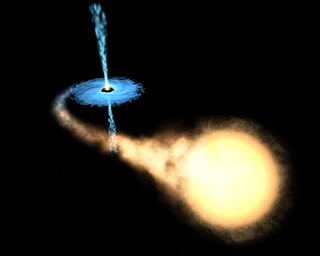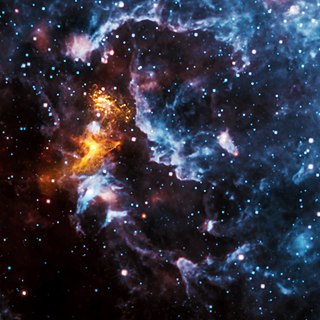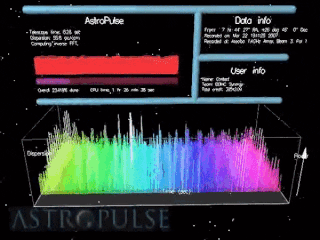Related Research Articles

A neutron star is the collapsed core of a massive supergiant star. It results from the supernova explosion of a massive star—combined with gravitational collapse—that compresses the core past white dwarf star density to that of atomic nuclei. Except for black holes, neutron stars are the smallest and densest known class of stellar objects. They have a radius on the order of 10 kilometers (6 mi) and a mass of about 1.4 M☉. Stars that collapse into neutron stars have a total mass of between 10 and 25 solar masses (M☉), or possibly more for those that are especially rich in elements heavier than hydrogen and helium.

A magnetar is a type of neutron star with an extremely powerful magnetic field (~109 to 1011 T, ~1013 to 1015 G). The magnetic-field decay powers the emission of high-energy electromagnetic radiation, particularly X-rays and gamma rays.

X-ray binaries are a class of binary stars that are luminous in X-rays. The X-rays are produced by matter falling from one component, called the donor, to the other component, called the accretor, which is either a neutron star or black hole. The infalling matter releases gravitational potential energy, up to 30 percent of its rest mass, as X-rays. The lifetime and the mass-transfer rate in an X-ray binary depends on the evolutionary status of the donor star, the mass ratio between the stellar components, and their orbital separation.
Stellar radio sources, radio source stars or radio stars are stellar objects that produce copious emissions of various radio frequencies, whether constant or pulsed. Radio emissions from stars can be produced in many varied ways.
X-ray pulsars or accretion-powered pulsars are a class of astronomical objects that are X-ray sources displaying strict periodic variations in X-ray intensity. The X-ray periods range from as little as a fraction of a second to as much as several minutes.
An astronomical radio source is an object in outer space that emits strong radio waves. Radio emission comes from a wide variety of sources. Such objects are among the most extreme and energetic physical processes in the universe.

A pulsar is a highly magnetized rotating neutron star that emits beams of electromagnetic radiation out of its magnetic poles. This radiation can be observed only when a beam of emission is pointing toward Earth, and is responsible for the pulsed appearance of emission. Neutron stars are very dense and have short, regular rotational periods. This produces a very precise interval between pulses that ranges from milliseconds to seconds for an individual pulsar. Pulsars are one of the candidates for the source of ultra-high-energy cosmic rays.

The Crab Pulsar is a relatively young neutron star. The star is the central star in the Crab Nebula, a remnant of the supernova SN 1054, which was widely observed on Earth in the year 1054. Discovered in 1968, the pulsar was the first to be connected with a supernova remnant.
GCRT J1745−3009 is a Galactic Center radio transient (GCRT), or bursting low-frequency radio source which lies in the direction of the Galactic Center.

Astropulse is a volunteer computing project to search for primordial black holes, pulsars, and extraterrestrial intelligence (ETI). Volunteer resources are harnessed through Berkeley Open Infrastructure for Network Computing (BOINC) platform. In 1999, the Space Sciences Laboratory launched SETI@home, which would rely on massively parallel computation on desktop computers scattered around the world. SETI@home utilizes recorded data from the Arecibo radio telescope and searches for narrow-bandwidth radio signals from space, signifying the presence of extraterrestrial technology. It was soon recognized that this same data might be scoured for other signals of value to the astronomy and physics community.

A radio-quiet neutron star is a neutron star that does not seem to emit radio emissions, but is still visible to Earth through electromagnetic radiation at other parts of the spectrum, particularly X-rays and gamma rays.
The Magnificent Seven is the informal name of a group of isolated young cooling neutron stars at a distance of 120 to 500 parsecs from Earth. These objects are also known under the names XDINS or simply XINS.

PSR B1937+21 is a pulsar located in the constellation Vulpecula a few degrees in the sky away from the first discovered pulsar, PSR B1919+21. The name PSR B1937+21 is derived from the word "pulsar" and the declination and right ascension at which it is located, with the "B" indicating that the coordinates are for the 1950.0 epoch. PSR B1937+21 was discovered in 1982 by Don Backer, Shri Kulkarni, Carl Heiles, Michael Davis, and Miller Goss.

Astrophysical X-ray sources are astronomical objects with physical properties which result in the emission of X-rays.
RRAT J1819-1458 is a Milky Way neutron star and the best studied of the class of rotating radio transients (RRATs) first discovered in 2006.
PSR J1614–2230 is a pulsar in a binary system with a white dwarf in the constellation Scorpius. It was discovered in 2006 with the Parkes telescope in a survey of unidentified gamma ray sources in the Energetic Gamma Ray Experiment Telescope catalog. PSR J1614–2230 is a millisecond pulsar, a type of neutron star, that spins on its axis roughly 317 times per second, corresponding to a period of 3.15 milliseconds. Like all pulsars, it emits radiation in a beam, similar to a lighthouse. Emission from PSR J1614–2230 is observed as pulses at the spin period of PSR J1614–2230. The pulsed nature of its emission allows for the arrival of individual pulses to be timed. By measuring the arrival time of pulses, astronomers observed the delay of pulse arrivals from PSR J1614–2230 when it was passing behind its companion from the vantage point of Earth. By measuring this delay, known as the Shapiro delay, astronomers determined the mass of PSR J1614–2230 and its companion. The team performing the observations found that the mass of PSR J1614–2230 is 1.97 ± 0.04 M☉. This mass made PSR J1614–2230 the most massive known neutron star at the time of discovery, and rules out many neutron star equations of state that include exotic matter such as hyperons and kaon condensates.

PALFA is a large-scale survey for radio pulsars at 1.4 GHz using the Arecibo 305-meter telescope and the ALFA multibeam receivers. It is the largest and most sensitive survey of the Galactic plane to date.

SGR 1935+2154 is a soft gamma repeater (SGR) that is an ancient stellar remnant, in the constellation Vulpecula, originally discovered in 2014 by the Neil Gehrels Swift Observatory. Currently, the SGR-phenomena and the related anomalous X-ray pulsars (AXP) are explained as arising from magnetars. On 28 April 2020, this remnant about 30,000 light-years away in our Milky Way galaxy was observed to be associated with a very powerful radio pulse known as a fast radio burst or FRB, and a related x-ray flare. The detection is notable as the first FRB detected inside the Milky Way, and the first to be linked to a known source. Later in 2020, SGR 1935+2154 was found to be associated with repeating fast radio bursts.
A central compact object (CCO) is an x-ray source found near the center of a young, nearby supernova remnant (SNR). Given the observed x-ray flux and spectra observed from these objects, the almost certain conclusion is that CCOs are the remnant neutron stars which resulted from the recent supernova. Unlike most pulsars, CCOs generally lack pulsed radio emission or variation in the observed x-rays due to such phenomena being either nonexistent or difficult to detect. The weaker magnetic fields than most other detected neutron stars means that most of the detected x-rays are due to blackbody radiation. Confirmation that the CCO is associated with the past supernova can be done using the kinematics of the objects and matching them to the age and kinematics of the host SNR.
ASKAP J1935+2148 is a neutron star/magnetar candidate located in the constellation Vulpecula, approximately 15,800 light-years away. With a rotation period of 53.8 minutes, it would be the slowest spinning neutron star ever discovered.
References
- 1 2 3 4 McLaughlin, M. A.; et al. (2006). "Transient radio bursts from rotating neutron stars". Nature. 439 (7078): 817–820. arXiv: astro-ph/0511587 . Bibcode:2006Natur.439..817M. doi:10.1038/nature04440. PMID 16482150. S2CID 4402381.
- 1 2 RRATALOG table
- ↑ Bjorn Carey (2007-02-15). "Astronomers Discover Peek-A-Boo Stars". Space.com .
- ↑ Burgay, M.; McLaughlin, M. A.; Reynolds, S. P. (2007). "On the debated nature of Rotating RAdio Transients". The multicolored landscape of compact objects and their explosive origins. AIP Conference Proceedings. Vol. 924. AIP Conference Proceedings. pp. 607–612. Bibcode:2007AIPC..924..607B. doi:10.1063/1.2774917.
- ↑ Gaensler, B. M.; et al. (2007). "Chandra smells a RRAT: X-ray Detection of a Rotating Radio Transient". Astrophysics and Space Science. 308 (1–4): 95–99. arXiv: astro-ph/0608311 . Bibcode:2007Ap&SS.308...95G. doi:10.1007/s10509-007-9352-8. S2CID 118787389.
- 1 2 3 4 McLaughlin, Maura (2009). "Rotating Radio Transients". In Warner Becker (ed.). Neutron Stars and Pulsars. Berlin: Springer. pp. 41–66.
- ↑ Zhang, B.; Gil, J.; Dyks, J. (2007). "On the origins of part-time radio pulsars". Monthly Notices of the Royal Astronomical Society . 374 (3): 1103–1107. arXiv: astro-ph/0601063 . Bibcode:2007MNRAS.374.1103Z. doi: 10.1111/j.1365-2966.2006.11226.x . S2CID 5995242.
- ↑ Cordes, J. M.; Shannon, R. M. (2008). "Rocking the Lighthouse: Circumpulsar Asteroids and Radio Intermittency". The Astrophysical Journal. 682 (2): 1152–1165. arXiv: astro-ph/0605145 . Bibcode:2008ApJ...682.1152C. doi:10.1086/589425. S2CID 17602731.
- ↑ Hu, H.-D.; Esamdin, A; Yuan, J.-P.; Liu, Z.-Y.; Xu, R.-X.; Li, J.; Tao, G.-C.; Wang, N. (2011). "Strong pulses detected from a rotating radio transient J1819-1458". Astronomy and Astrophysics . 530: A67. arXiv: 1104.3256 . Bibcode:2011A&A...530A..67H. doi:10.1051/0004-6361/201015953. S2CID 53482941.